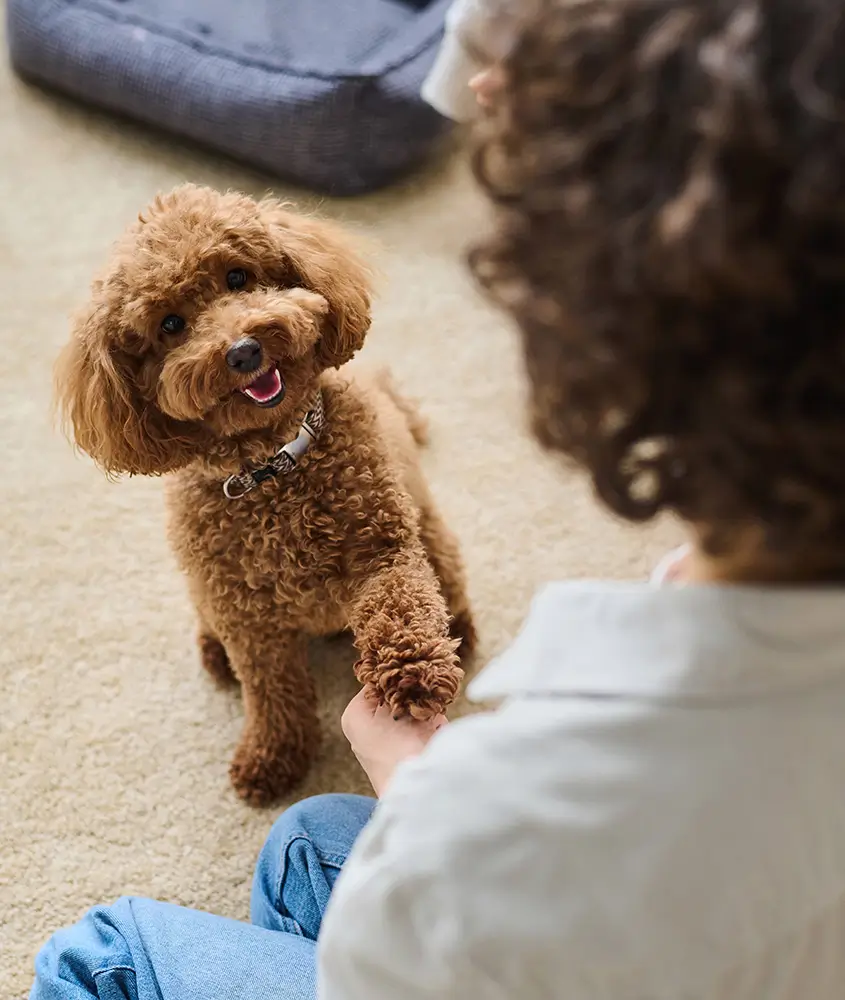Pet Sitter Certification Program
This course will equip pet sitters with a scientifically sound knowledge base in animal body language, dog walking, behavior and training basics, enrichment, home life, travel, administering medications, and more so that they can offer top-level Fear Free care to pets and provide owners with basic support and advice.

Pet Sitter Membership
This membership is designed for pet sitting professionals. The certification program included with this membership will equip pet sitters with a scientifically sound knowledge base in animal body language, dog walking, behavior and training basics, enrichment, home life, travel, administering medications, and more so that they can offer top-level Fear Free care to pets and provide owners with basic support and advice.

Course Overview
The Pet Sitter Certification Program will equip pet sitters with a scientifically sound knowledge base in animal body language, dog walking, behavior and training basics, enrichment, home life, travel, administering medications, and more so that they can offer top-level Fear Free care to pets and provide owners with basic support and advice. The Fear Free Certified® pet sitter will be empowered to help educate pet owners on reading dog and cat body language and provide ideas for how enrichment and training can be incorporated into the pet’s environment and routine, promoting not only a calmer pet-sitting stay but also a richer, more fulfilling life. We’ll cover everything from the very first greeting of a pet to creating calmer leash walks to delivering medications in a Fear Free manner and much more! This course was reviewed by PSI (Pet Sitters International) and NAPPS (National Association of Professional Pet Sitters).
Course author: Mikkel Becker, CBCC-KA, CPDT-KA, KPA CTP, CDBC, CTC
This course is approved through the following organizations:
- 6 hours of PACCC CEUs
Lesson 1: The Impact of Fear, Anxiety and Stress
After completing this lesson, you will be able to:
- Define fear, anxiety, and stress (FAS)
- Explain changes that occur in a body resulting from elevated levels of fear, anxiety, and stress
- Detail ways in which high stress alters normal thinking and functioning
- Explain some of the ways that chronic stress impacts the body
Lesson 2: Dog and Cat Body Language 101
After completing this lesson, you will be able to:
- Recognize the importance of reading body language signals
- Explain the stress responses known as the “Four Fs”
- Note body language signals indicating rising FAS in dogs and cats
Lesson 3: Considerate Approach
After completing this lesson, you will be able to:
- Define Considerate Approach and give examples of how to employ it while pet sitting dogs and cats
- State how underlying illness and pain impact the animal’s experience
- Describe common signs of pain in animals
Lesson 4: Gentle Control
After completing this lesson, you will be able to:
- Describe Gentle Control and why it’s important
- Describe three strategies involved in positioning a pet for Gentle Control
- Identify at least two Gentle Control tools and why they are useful
- Explain Touch Gradient and how it’s incorporated into Gentle Control handling
Lesson 1: The Impact of Genetics on Behavior
After completing this lesson, you will be able to:
- Describe ways genetics influence behavior
- Understand how key characteristics of different breeds such as Labradors and German shepherds influence their personality and behavior
Lesson 2: Life Stages of Dogs and Cats
After completing this lesson, you will be able to:
- Indicate the timeframe of the socialization periods for dogs and cats
- Explain basic guidelines for successful socialization experiences
- List common challenges experienced during adolescence and how you can help adolescent dogs
- Describe various cognitive changes that senior animals commonly experience
Lesson 3: Enriching Animals’ Lives
After completing this lesson, you will be able to:
- Describe why enrichment for pets, especially those who might be stressed while their parents are away, is important
- Give examples of simple enrichment strategies to employ with the pets you are sitting, including food-based, scent-based, and exploration-based
Lesson 4: Training and Behavior Basics
After completing this lesson, you will be able to:
- Describe how classical conditioning and desensitization can help pet sitters when they are working with fearful or anxious pets
- Explain how pet sitters can use capturing, targeting, and shaping with the pets they care for
- Describe the dangers of using punishment and why it should be avoided
- Demonstrate how positive reinforcement can be used to replace unwanted behaviors such as barking, jumping up, scratching the furniture, and more
Lesson 1: Client Intake: What You Should Ask
After completing this lesson, you will be able to:
- List at least three key pieces of information you should gather about the pet you will be sitting
- Define and give examples of a treat ladder
- Explain three details to secure when obtaining emergency contact information
Lesson 2: Greeting Pets Safely
After completing this lesson, you will be able to:
- Recount two reasons why meeting the pet prior to care is important
- State three ways to reduce pets’ stress when you greet them
- List strategies to keep yourself safe while greeting overly exuberant dogs
- Relay different positives that can be integrated into a meet-and-greet scenario
Lesson 3: Settling In
After completing this lesson, you will be able to:
- Explain stress-reduction methods to employ in the pet’s home
- List actions you can take to help a cat or dog settle in
Lesson 4: Calmer Car Rides and Carriers
After completing this lesson, you will be able to:
- List ways to prepare the vehicle ahead of time for a Fear Free car ride
- List three tips for encouraging a pet to move into the carrier by choice
- Describe strategies for encouraging a reluctant pet to feel more comfortable with their carrier
- Describe how a pet carrier is best positioned for car travel
Lesson 1: Applying Fear Free Concepts to Home Care
After completing this lesson, you will be able to:
- Describe how the FAS Scale and FAS Spectrum can be incorporated into physical care to monitor and respond appropriately to FAS
- List three Considerate Approach strategies useful for setting up a soothing surrounding environment for the pet’s care
- State three ways Gentle Control can be incorporated for positioning an animal in a stationary position for an aspect of care, like removing a burr from a dog’s coat
- Explain how Touch Gradient helps you handle sensitive areas of the animal’s body, such as a paw or an ear
- Provide two tips for treating a pet with dietary sensitivities and limitations
Lesson 2: Distractions and How to Use Them
After completing this lesson, you will be able to:
- Detail when distraction techniques are useful during home care
- List two limitations of distractions
- Provide two tips for calmer baths
Lesson 3: Touch = Treat
After completing this lesson, you will be able to:
- Explain how a “touch = treat”-type method differs from distraction
- Elaborate on when “touch = treat” is preferable to distraction-based methods
Lesson 4: Accustoming Pets to Tools and Equipment
After completing this lesson, you will be able to:
- Provide a step-by-step plan to introduce care equipment in a less stressful way to the dog or cat
- Incorporate Touch Gradient into bringing tools near the animal for delivery of care
- Relay three training steps for more calmly placing wearable equipment, like an Elizabethan collar (cone)
Lesson 5: Administering Medications
After completing this lesson, you will be able to:
- List three strategies for Fear Free delivery of topical medications
- List two ways to provide medications more successfully with a pet who dislikes taking pills
- State how distractions may be used while administering ear or eye medications
Lesson 6: Cooperative Care
After completing this lesson, you will be able to:
- Define a Treat-Ment Station
- Explain two steps for familiarizing an animal to a Treat-Ment station space
Lesson 1: Unleashing a Calmer Walk
After completing this lesson, you will be able to:
- List recommended walking equipment that a Fear Free pet sitter might use for calmer, more controlled walks
- Offer some appropriate options for strong pulling dogs or reactive dogs
- Describe several safe walking strategies for Fear Free pet sitters
- Highlight more effective leash-holding techniques
- Suggest safe, effective ways to break up a dog fight
Lesson 2: Treating and Preventing Stress-Induced Illness
After completing this lesson, you will be able to:
- Elaborate upon how change or lack of predictability can negatively impact pets
- Detail common signs of sickness cats and dogs present when stressed
- List some possible options for dealing with stress diarrhea
Lesson 3: Addressing Behavior Issues
After completing this lesson, you will be able to:
- Explain a Fear Free pet sitter’s approach to being asked to use tools they’re not comfortable with
- List two examples of how management may help prevent problem behavior
- Describe one way positive reinforcement can help improve animal behavior
Lesson 4: Marketing and Growth Opportunities
After completing this lesson, you will be able to:
- Define key factors important to your Fear Free pet-sitting business’ mission statement and core values
- List three key rules of marketing
- Identify possible value propositions for potential clients
- Determine strategies to communicate Fear Free to your clients

Member Benefits
Discover the exclusive benefits included with the Pet Sitter Membership. In addition to the applicable certification program, your membership gives you access to so much more!
Additional Courses
Deepen your Fear Free knowledge and earn more CE. Explore all courses here.
Marketing Resources
Download logos, email signatures, social media graphics, and more!
Educational Resources
Peruse client communication handouts, fear, anxiety and stress assets, questionnaires, and more!
Directory Listing
Once individually certified, members have the opportunity to opt-in to be found in our online directory. Find a Fear Free certified professional or practice near you.
Certification Kit
Once individually certified, members are able to order a complimentary gift to celebrate their new certification.
Facebook Community
Join our exclusive, members-only Facebook group to share advice and connect with other Fear Free professionals.
Product Discounts
Enjoy special pricing on products and services that are aligned with our values. View Friends of Fear Free.
Merchandise & Swag
Our online store is exclusive to active members who can purchase merch and swag to promote certification status.
Requirements
To successfully attain and maintain certification, all members must:
- Pass each online module with a score of 80% or higher.
- Sign and uphold to the Fear Free Pledge, a commitment to follow a humane, emotionally protective code of conduct and ethical standards.
- Keep an active membership.
Pet Professional Membership Pricing
This category of memberships are renewed annually from the date of purchase or date of membership assignment by a Team Administrator. All pricing is in USD. Memberships available within Pet Professional memberships include trainer, groomer, pet sitter, and boarding & daycare individuals. These memberships function independently and cannot be combined.
Number of Members
Annual Renewal
Member Pricing*
Individuals with an existing, active Fear Free membership can purchase any additional pet professional membership for $119. This special member pricing is only available to memberships within the pet professional membership category.